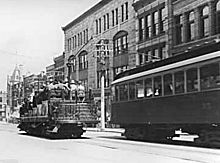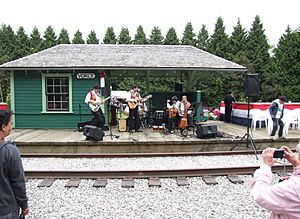British Columbia Electric Railway facts for kids

BCER sightseeing trolley car on Granville Street in Vancouver (1910)
|
|
| Overview | |
|---|---|
| Headquarters | Vancouver |
| Locale | southwestern British Columbia and Vancouver Island |
| Dates of operation | 1897–1979 |
| Predecessor | National Electric Tramway and Lighting Company Limited (1890); Vancouver Electric Railway and Light Company Limited (1890); Westminster and Vancouver Tramway Company (1891) |
| Successor | BC Hydro, Southern Railway of British Columbia, TransLink (British Columbia), BC Transit |
| Technical | |
| Track gauge | 4 ft 8 1⁄2 in (1,435 mm) standard gauge |
The British Columbia Electric Railway (BCER) was an important railway in southwestern British Columbia, Canada. It started in 1897 and was part of the BC Electric Company (which is now BC Hydro). The BCER took over existing streetcar and interurban (longer-distance electric train) lines.
It ran electric railway systems until 1958. After the streetcar era, BC Electric also operated bus and trolleybus systems. These systems later became part of BC Transit and then TransLink. Today, trolley buses still run in Vancouver.
Contents
- History of BCER
- How BCER Got Its Power
- BCER Interurban Rail Lines
- Vancouver-Marpole Line
- Marpole-Steveston Line (Lulu Island Branch)
- Marpole-New Westminster Line
- New Westminster to Chilliwack Line (Fraser Valley Branch)
- Burnaby Lake Line
- Central Park Line
- New Westminster to Queensborough Line
- New Westminster to Fraser Mills Line
- Victoria to Deep Bay Line
- Stave Lake Line
- Port Moody-Coquitlam Line
- Alouette Lake Line
- Jordan River Line
- From Rails to Rubber
- Remaining BCER Cars
History of BCER
Streetcar and interurban services first began in British Columbia between 1890 and 1891. Three different companies started these services:
- National Electric Tramway and Lighting Company Limited: Started streetcars in Victoria on February 22, 1890.
- Vancouver Electric Railway and Light Company Limited: Launched Vancouver's streetcar system on June 27, 1890.
- Vancouver & Westminster Tramway Company: Started New Westminster's streetcar system on October 8, 1891. This company also opened the Vancouver-New Westminster interurban line that same year.
In the 1890s, there was a global economic downturn. All three companies faced financial trouble. They joined together in 1895 to form the Consolidated Railway and Light Company. However, this new company also ran into problems. After a serious streetcar accident in Victoria (the Point Ellice Bridge Disaster) caused many deaths, the company was reorganized. It became the British Columbia Electric Railway Company Limited in April 1897.
How BCER Got Its Power
The BCER's electric trains needed a lot of power. This power came from special projects at Buntzen Lake and on the Stave River. These projects were built mainly to provide electricity for the interurbans and street railways. They were very advanced for their time.
BCER Interurban Rail Lines
The BCER operated several key interurban lines. These lines connected different towns and cities, making travel easier.
Vancouver-Marpole Line
The BCER began the Vancouver-Steveston interurban and freight service in 1905. They leased the line from Canadian Pacific Railway (CPR) and added electricity. The northern part of the Vancouver-Marpole line ran next to Arbutus Street. The CPR continued to use this section for freight trains until 2001.
Marpole-Steveston Line (Lulu Island Branch)
The Steveston line on Lulu Island followed certain roads. These included Railway Avenue, Granville Avenue, Garden City Road, and Great Canadian Way. Passenger service on this line ended in 1958.
Marpole-New Westminster Line
Interurban service between Marpole and New Westminster started in 1909. This line ran along the North Arm of the Fraser River. Today, parts of this line are still used by the Southern Railway of British Columbia for freight.
New Westminster to Chilliwack Line (Fraser Valley Branch)
This line opened on October 4, 1910. It was used for both passengers and freight. Like the Marpole-New Westminster line, it is still used today by the Southern Railway of British Columbia. This line crossed the New Westminster Bridge, which opened in 1904.

Burnaby Lake Line
Much of the Burnaby Lake line's path is now used by the Trans-Canada Highway. However, some parts of it remain as walking and biking trails.
Central Park Line
After interurban services stopped on the Central Park Line, its path was controlled by BC Hydro. In 1975, there was a plan to use this path for a light rail line. This line would connect Vancouver and New Westminster. The provincial government eventually took over this project. It became the Vancouver SkyTrain's Expo Line.
New Westminster to Queensborough Line
The tracks from New Westminster to Queensborough are still in use. The 'Railway Bridge' across the north arm of the Fraser River is also still active. These are now part of the Southern Railway of British Columbia.
New Westminster to Fraser Mills Line
This line opened in 1912. However, new ramps for the Pattullo Bridge led to its closure in 1937. The Queensborough and Fraser Mills lines closed. The Burnaby Lake line was also shortened.
Victoria to Deep Bay Line
This line, opened in 1913, connected Victoria to what is now called Deep Cove. It was one of three passenger railways on the Saanich Peninsula. It closed on November 1, 1924, because not enough people were using it. You can still trace its path today through various roads and trails.
Stave Lake Line
This was a 6-mile (9.7 km) steam train line. It was built during the construction of the original Stave Falls hydroelectric plant. It connected the power plant at Stave Falls to the Canadian Pacific Railway station at Ruskin. Parts of its route are now walking trails.
Port Moody-Coquitlam Line
The Port Moody-Coquitlam Railway connected the Port Moody-Ioco spur of the Canadian Pacific Railway to the Coquitlam Dam. It was used to transport supplies and materials for the dam.
Alouette Lake Line
Similar to the Stave Lake line, the Alouette Lake dam tracks connected power facilities to the CPR. These tracks ran on the north side of the Fraser River at Kanaka Creek in Haney.
Jordan River Line
This 5.3-mile (8.5 km) railway connected the powerhouse and harbor at the mouth of the Jordan River to the Jordan River Dam.
From Rails to Rubber
The BCER gradually stopped its streetcar services. New Westminster's streetcar service ended on December 5, 1938. The company announced its "Rails-to-Rubber" plan in 1944. This plan meant replacing streetcars with buses and trolleybuses.
North Vancouver's last streetcar service ended in April 1947. Victoria's streetcar service stopped on July 4, 1948. The Chilliwack interurban line closed in 1950. The Vancouver-Marpole line closed in 1952. The Burnaby Lake line closed in 1953.
The Central Park line closed in stages, with the last part in Vancouver ending on July 16, 1954. The very last streetcar line in Vancouver ran on April 22, 1955. The Marpole-New Westminster interurban line closed in 1956. Finally, the Marpole-Steveston line closed on February 28, 1958. This marked the end of the entire interurban system.
In 1961, the provincial government took over BC Electric. The railway then became a part of Crown corporation BC Hydro. In 1988, BC Hydro sold its freight railway division. This division became the Southern Railway of British Columbia. It now operates only as a freight railway.
There have been ideas to bring back passenger rail service on some of these lines. However, studies have shown that it would be very expensive and might not attract enough riders.
Remaining BCER Cars
After the BCER streetcar and interurban system closed, most cars were either scrapped or burned. But some cars were sold and used as bunkhouses, storage sheds, or even decorations. A few cars were also given to museums. Since then, many groups have bought back and started restoring these old cars.
Here is a list of known BCER cars that still exist (as of January 2016):
Streetcars
- #53 Built in 1904, it operated in Vancouver. It is now on display inside The Old Spaghetti Factory in Gastown, Vancouver, BC.
- #153 Built in 1908, it operated in North Vancouver. It is currently on display at the Museum of North Vancouver (MoNoVa), North Vancouver, BC.
- #400 Built in 1922, it operated in Victoria. It is now located at the Nelson Electric Tramway Society in Nelson, BC.
Interurban Cars
- #1207 Built in 1905, it operated on the Marpole-Steveston Line. It was moved to the Fraser Valley Historical Railway Society, Cloverdale, BC.
- #1220 Built in 1913, it operated on the Marpole-Steveston Line. It is currently being restored at the Steveston Tram Museum, Richmond, BC.
- #1223 Built in 1913, it operated on the Burnaby Lake Line. It is on display at the Burnaby Village Museum, Burnaby, BC.
- #1225 Built in 1913, it operated on the Marpole-Steveston and Burnaby Lake Lines. It is currently in operation at the Fraser Valley Historical Railway Society, Cloverdale, BC.
- #1231 Built in 1913, it operated on the Marpole-Steveston and Burnaby Lake Lines. It is now located at the Fraser Valley Historical Railway Society, Cloverdale, BC.
- #1235 Built in 1913, it operated on the Marpole-Steveston Line. It is located at the Canada Science and Technology Museum, Ottawa, ON.
- #1304 Built in 1911, it operated on the Fraser Valley-Chilliwack Line. It is currently being restored at the Fraser Valley Historical Railway Society, Cloverdale, BC.

